A mid-year vacation in Bali proved to be a hit with the family. We loved the weather -- sunny, bright mornings and breezy star-filled sky evenings, so different from the muggy, wet, opressively sticky and heavy HK one we left behind and came home to again. Hubby didn't embrace Indonesian cuisine, mostly because he couldn't appreciate the complex flavors brought on by using as many as 20- plus spices in one dish! He prefers Indian dishes, which, to him, is all about fiery hot curry! Indonesian food isn't as spicy (at least the ones we tried; I read that Indonesia was the center of the spice trade centuries ago) and the flavors are subtle, but the depth is astounding. To my surprise, little boy hungrily finished off his chicken satay and crispy fried duck,
Bebek Bengil style. So after our first dinner at
Bumbu Bali, which is both a cooking school and stylish restaurant feauring authentic Indonesian cuisine, we decided to compromise. Hubby could have his McDo and familiar food fix, while I could try whatever I wanted. Good deal!
At Bumbu Bali we tried the mixed satay appetizer consisting of
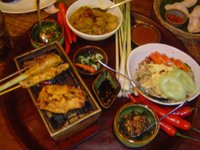
chicken, beef, lamb and seafood satay. The seafood was presented on sugarcane sticks, the rest on wooden bbq sticks or wide popsicle sticks. I was impressed with the peanut sauce, which had the right balance of sweet, salty and spicy. It came with a bowl of bland sticky rice cubes with a sprinkling of browned shallots. Hubby ordered the nasi goreng, the most popular Indonesian dish to have left its shores. It is basically Indoneisan fried rice with egg on top and chicken, beef and fish satay on the side. I had the lamb in coconut sauce and it was fantastic! Generous cubes of soft lamb lay swimming in a fragrant coconut-based sauce redolent with Indonesian spices. The servers will approach you every so often with a choice of three, count that, THREE kinds of steamed rice. Plain white rice, red rice and brown rice. I had the red rice with my lamb and pretty soon little boy was eating a mixture of nasi goreng, beef satay and red rice and he loved it! My only complaint? I had to eat everything! Since hubby didn't take to the food, it was up to me to make sure we weren't wasting our money and time. I had a tummyache after, not because there was anything wrong with the food-- I just overate! The vegetables, which accompanied every order, were composed of something similar to sauteed morning glory, spicy pickled sprouts (kimchi-like in texture and tang but definitly not as spicy), and a crunchy cucumber salad. They were all yummy and went perfectly with the lamb.

Breakfast, which was included in our stay, made the whole trip worthwhile for hubby. It was the usual hotel buffet breakfast, with copious amounts of tea, coffee, juice, iced coffee, milk being offered by the servers left and right. The buffet tables were groaning with the weight of their offerings. One side of a table was laden with fresh fruits: pineapple, watermelon, yellow watermelon, honeydew melon, rockmelon, papaya, oranges and the curious-looking snakeskin fruit or snakefruit (called Salak by the natives).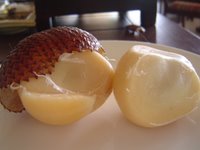

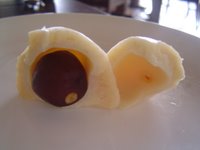
An unopened salak with its reddish-brown, slightly prickly skin; two roundish occupants inside; it is crunchy and sour and mapakla (leaves an unpleasant coating in the tongue, usually attributed to unripe fruit) all at the same time
The other side was chock-full of small cereal boxes with choices like nut bran, muesli, plain old cornflakes, and rice pops. Beside it were three pitchers of dairy: soy, skim and full cream milk. Adorning the rest of the table were bowls of oatmeal, whipped cream, cottage cheese and cream cheese, prunes, canned peaches and paoched pear.
Other choices included: bacon; pork and chicken sausage; an omelet, egg, waffle and pancake station; dimsum; fried rice and steamed rice; stir-fried noodles; noodle soup; a carvery serving either roast chicken, roast beef, ham or rosemary porkloin, depending on the day; a bread corner with foccacia, at least five kinds of rolls, pizza, banana bread, danish, croissant, toast; a cheese board; salad station; Miso soup, Korean soup and traditional Balinese breakfast corner; smoked salmon, prosciutto (which I couldn't get enough of), ham and smoked fish. Whew!
Needless to say, breakfast was overwhelming! And with bacon and rice to start his day and fuel him up, hubby started to wax poetic about Bali.
I didn't care much for all the trappings of a Western breakfast so I amused myself by making my own sandwich (toast, ham, 3 kinds of mustard, salad greens, cheese) one time, plating some prosciutto and melon another time and pretending I was in Italy, trying out miso soup and a fiery hot noodle soup along with strawberry pancakes and oatmeal with pear.
One time for lunch we went to the famous Bebek Bengil restaurant in Ubud, but sadly I thought their crispy duck marinated in secret spices and flavorings tasted and looked like a malnourished, bony Max's fried spring chicken (and I don't like Max's that much, so you can get how disappointed I was). The barbequed pork ribs were tough, the portion tiny and the sauce tasted of ketchup, way too much ketchup and way too little of everything else that's suposed to make it smoky and sweet!The place was nice though, with a ricefield out back, a lot of ponds and fountains and Indonesian dieties watching while you ate.
At Uno Italian restaurant in the sprawling commercial complex called Bali Collection in Nusa Dua, we enjoyed bolognese, carbonara and piccata milanese. I didn't care too much for the veal batter, but the tomato-garlic sauce accompanying the buttered noodles I immediately took a liking to. Not too garlicky nor sour, the hint of sweetness and herbs teased the palate. Portions were plentiful, the price was right, and I got a kick out of taking this picture of my refreshing mango shake against the bright blue tablecloths.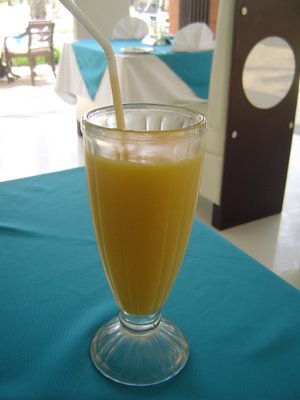


Obvioulsy little boy was more than satisfied with his carbonara and I had to finish this large serving of piccata milanese.
Our last dinner on the island was a romantic one. Some friends suggested we go to Ku de ta, a swanky, beachfront restaurant run by Australians that turns into a cool bar after dinner. Our son decided to cooperate by sleeping on the way there and not waking up until we were done! Miracle of miracles! He slept soundly despite the "club" atmosphere, screams of children running around the garden, and the funky music. We started off with a crackling pork belly appetizer. The pork belly was simply lechon kawali sitting prettily atop a bed of inspiringly delicious julienned mango, cucumber and shredded king crab salad. Hubby had winter rissotto with liberal quantities of lobster and roasted chesnuts. I tried the roast baby chicken stuffed with spiced pumpkin and pine nuts, lording it over a deep plate filled with richly-flavored French lentils with a dash of cream, with some baby bokchoy coyly peeking from underneath the chicken. Both mains got a nod of approval from us, because they were inventive but didn't stray too far from mainstream cuisine, thereby satisfying hubby's craving for familiar tastes and my love of flavor interplay.
Dessert was taken back at the resort with the breeze ruffling our hair. With every bite of the iced tiramisu (mascarpone and espresso ice cream on a liqueur-soaked sponge bed), we said our goodbyes to Bali, with its palm and coconut trees, clear night skies studded with stars, small towns with friendly people, artisans, well-preserved temples and heritage sites, and their famous coffee (we are not drinkers ourselves, but a friend swears by Toraja Kalosi). The beaches are nothing compared to Boracay, but the resorts are something else. 

 Chocolate and Egg Mille -feuille at CaffeChocola in Macau
Chocolate and Egg Mille -feuille at CaffeChocola in Macau The rissol camarao (shrimp rissoles) beckoned...
The rissol camarao (shrimp rissoles) beckoned...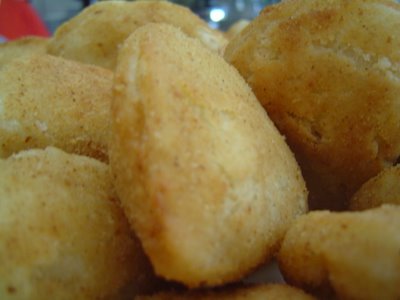 A closer look at the deep-fried wonders with shrimp and potato. My friend loved it!
A closer look at the deep-fried wonders with shrimp and potato. My friend loved it!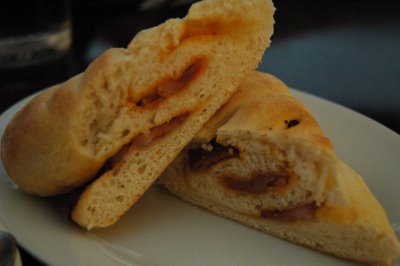 I always have this for breakfast in Macau -pao con chourico (chorizo bread). 90 % bread, 10% chorizo. Yummy, nonetheless.
I always have this for breakfast in Macau -pao con chourico (chorizo bread). 90 % bread, 10% chorizo. Yummy, nonetheless. From top clockwise: galao de maquina (coffee with milk, and, like the chorizo bread, it's probably 10% coffee, 90% milk), pan con chourico, rissol camarao and, peeking from top right, Black Forest cake. The cake was one of the densest versions I've tried. They could have added more liquor and cherries, but the cake's dense crumb was moist , the chocolate shavings on top generous, and I appreciated the fact that there was infinitely more cake than buttercream. We also ordered ham and cheese quiche but it was too dry. Overcooked, most likely.
From top clockwise: galao de maquina (coffee with milk, and, like the chorizo bread, it's probably 10% coffee, 90% milk), pan con chourico, rissol camarao and, peeking from top right, Black Forest cake. The cake was one of the densest versions I've tried. They could have added more liquor and cherries, but the cake's dense crumb was moist , the chocolate shavings on top generous, and I appreciated the fact that there was infinitely more cake than buttercream. We also ordered ham and cheese quiche but it was too dry. Overcooked, most likely. The last small piece of chorizo bread sharing space with the Black Forest crumbs on my plate. I lugged home a heavy can of chorizos and have served them for chorizo rice; pan-grilled with some garlic; to enliven a chicken and okra stew. I have 3 pieces left. Pasta maybe, and if anyone has ideas, feel free to comment. :)
The last small piece of chorizo bread sharing space with the Black Forest crumbs on my plate. I lugged home a heavy can of chorizos and have served them for chorizo rice; pan-grilled with some garlic; to enliven a chicken and okra stew. I have 3 pieces left. Pasta maybe, and if anyone has ideas, feel free to comment. :) In Macau, the bread will always be bigger than your fist (unless you have big fists), freshly-baked, with a thin,crisp crust and soft, chewy, fragrant, absorbent core. Mopping up sauces has never been this delicious!
In Macau, the bread will always be bigger than your fist (unless you have big fists), freshly-baked, with a thin,crisp crust and soft, chewy, fragrant, absorbent core. Mopping up sauces has never been this delicious! At Fernando's near Hac Sa Beach, Coloane: their FAMOUS, and I mean FAMOUS garlic prawns. Succulent meat, easy- to -peel shell, the sauce a heady mixture of garlic, olive oil and chili. Suck the juice out of the head, use the bread if you can't get enough of the sauce. This dish is simple yet outstanding. You could forget yourslef while eating this. Need I say more?
At Fernando's near Hac Sa Beach, Coloane: their FAMOUS, and I mean FAMOUS garlic prawns. Succulent meat, easy- to -peel shell, the sauce a heady mixture of garlic, olive oil and chili. Suck the juice out of the head, use the bread if you can't get enough of the sauce. This dish is simple yet outstanding. You could forget yourslef while eating this. Need I say more? Sliced and grilled chorizo. Lots of off-white fatty bits on each reddish-brown slice of ecstasy. Woohoo!
Sliced and grilled chorizo. Lots of off-white fatty bits on each reddish-brown slice of ecstasy. Woohoo! Dimsum lunch at Metropol. Top row: Steamed BBQ pork bun (no way can any siopao in Manila compare to this), siomai (only in HK, and maybe Vancouver, do they come as generously-sized as this, with 1 whole crunchy shrimp on top), beancurd sheet roll stuffed with mushrooms. 2nd row: the ubiquitous ha kaw or steamed shrimp dumpling, deep-fried spring rolls, condiments for congee, assorted meat congee. Bottom: Sticky rice dumpling with chicken. Although I miss my Aunt's Fookien-style ma-chang (the pork fat of which I ingest without shame or guilt), this parcel of savory brown glutinous rice is a delightful replacement.
Dimsum lunch at Metropol. Top row: Steamed BBQ pork bun (no way can any siopao in Manila compare to this), siomai (only in HK, and maybe Vancouver, do they come as generously-sized as this, with 1 whole crunchy shrimp on top), beancurd sheet roll stuffed with mushrooms. 2nd row: the ubiquitous ha kaw or steamed shrimp dumpling, deep-fried spring rolls, condiments for congee, assorted meat congee. Bottom: Sticky rice dumpling with chicken. Although I miss my Aunt's Fookien-style ma-chang (the pork fat of which I ingest without shame or guilt), this parcel of savory brown glutinous rice is a delightful replacement. Close -up of the BBQ Pork Bun (or cha siu pao), siu mai and ha kaw.
Close -up of the BBQ Pork Bun (or cha siu pao), siu mai and ha kaw. From a different angle. We were 3 diners. Did we order too much or what?!
From a different angle. We were 3 diners. Did we order too much or what?! Roast crispy pork with a salty sauce that tastes a bit like a quirky blend of hoisin and shrimp paste. I need to research on what this sauce is made of. I think black beans, maybe. The strips are resting on a bed of peanuts in all their pure, fattening, "who-cares they-taste-so-good" glory.
Roast crispy pork with a salty sauce that tastes a bit like a quirky blend of hoisin and shrimp paste. I need to research on what this sauce is made of. I think black beans, maybe. The strips are resting on a bed of peanuts in all their pure, fattening, "who-cares they-taste-so-good" glory.




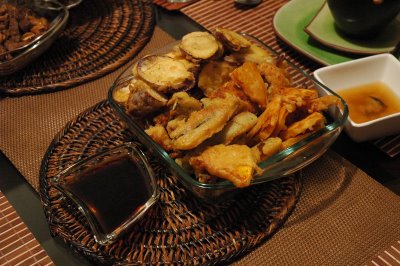



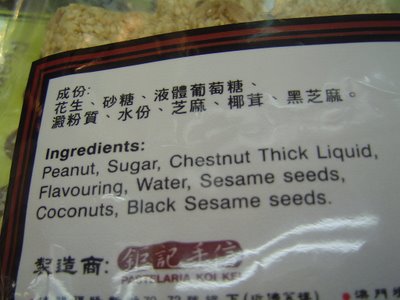
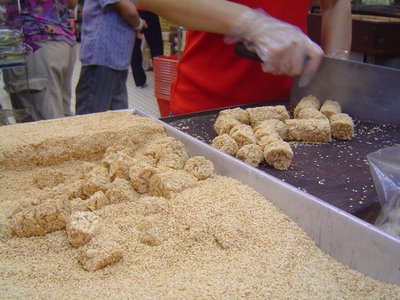


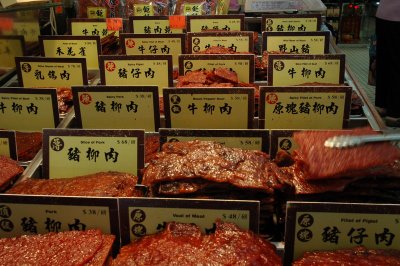
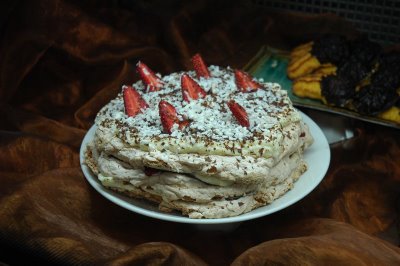

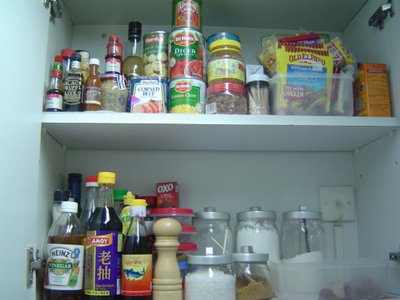

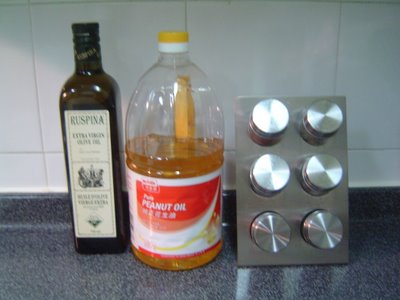
 chicken, beef, lamb and seafood satay. The seafood was presented on sugarcane sticks, the rest on wooden bbq sticks or wide popsicle sticks. I was impressed with the peanut sauce, which had the right balance of sweet, salty and spicy. It came with a bowl of bland sticky rice cubes with a sprinkling of browned shallots. Hubby ordered the nasi goreng, the most popular Indonesian dish to have left its shores. It is basically Indoneisan fried rice with egg on top and chicken, beef and fish satay on the side. I had the lamb in coconut sauce and it was fantastic! Generous cubes of soft lamb lay swimming in a fragrant coconut-based sauce redolent with Indonesian spices. The servers will approach you every so often with a choice of three, count that, THREE kinds of steamed rice. Plain white rice, red rice and brown rice. I had the red rice with my lamb and pretty soon little boy was eating a mixture of nasi goreng, beef satay and red rice and he loved it! My only complaint? I had to eat everything! Since hubby didn't take to the food, it was up to me to make sure we weren't wasting our money and time. I had a tummyache after, not because there was anything wrong with the food-- I just overate! The vegetables, which accompanied every order, were composed of something similar to sauteed morning glory, spicy pickled sprouts (kimchi-like in texture and tang but definitly not as spicy), and a crunchy cucumber salad. They were all yummy and went perfectly with the lamb.
chicken, beef, lamb and seafood satay. The seafood was presented on sugarcane sticks, the rest on wooden bbq sticks or wide popsicle sticks. I was impressed with the peanut sauce, which had the right balance of sweet, salty and spicy. It came with a bowl of bland sticky rice cubes with a sprinkling of browned shallots. Hubby ordered the nasi goreng, the most popular Indonesian dish to have left its shores. It is basically Indoneisan fried rice with egg on top and chicken, beef and fish satay on the side. I had the lamb in coconut sauce and it was fantastic! Generous cubes of soft lamb lay swimming in a fragrant coconut-based sauce redolent with Indonesian spices. The servers will approach you every so often with a choice of three, count that, THREE kinds of steamed rice. Plain white rice, red rice and brown rice. I had the red rice with my lamb and pretty soon little boy was eating a mixture of nasi goreng, beef satay and red rice and he loved it! My only complaint? I had to eat everything! Since hubby didn't take to the food, it was up to me to make sure we weren't wasting our money and time. I had a tummyache after, not because there was anything wrong with the food-- I just overate! The vegetables, which accompanied every order, were composed of something similar to sauteed morning glory, spicy pickled sprouts (kimchi-like in texture and tang but definitly not as spicy), and a crunchy cucumber salad. They were all yummy and went perfectly with the lamb.













 The stuffing is made up of thickly sliced black mushrooms, mustard greens, sometimes pork or other native Chinese ingredients. Five-spice powder and star anise lend this dish its Oriental, somewhat herb-y and medicinal scent. It has an acquired taste, and despite the pomp and pageantry accompanying an order, some people just plain don't like the way it tastes. I've tried this twice, in the same restaurant but with different people, and I can honestly say only a handful of us adventurous eaters chewed, bit, chomped and sucked our way through to the bones.
The stuffing is made up of thickly sliced black mushrooms, mustard greens, sometimes pork or other native Chinese ingredients. Five-spice powder and star anise lend this dish its Oriental, somewhat herb-y and medicinal scent. It has an acquired taste, and despite the pomp and pageantry accompanying an order, some people just plain don't like the way it tastes. I've tried this twice, in the same restaurant but with different people, and I can honestly say only a handful of us adventurous eaters chewed, bit, chomped and sucked our way through to the bones. 



 I was too entranced by the decors that I forgot my main purpose in bringing the camera - to capture our unforgettable mezze platter appetizer and dinner of lamb tagine and lamb couscous. Good thing I got some pictures of the colorful hanging lamps, brassware, pottery and wall hangings. I even took a picture of the charming braided red lamp in the ladies' room. It looked like an inverted flower pot with red dreadlocked strings attached.
I was too entranced by the decors that I forgot my main purpose in bringing the camera - to capture our unforgettable mezze platter appetizer and dinner of lamb tagine and lamb couscous. Good thing I got some pictures of the colorful hanging lamps, brassware, pottery and wall hangings. I even took a picture of the charming braided red lamp in the ladies' room. It looked like an inverted flower pot with red dreadlocked strings attached.